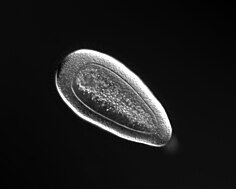447:
504:
70:
105:
Depending on the species, the planula either metamorphoses directly into a free-swimming, miniature version of the mobile adult form, or navigates through the water until it reaches a hard substrate (many may prefer specific substrates) where it anchors and grows into a polyp. The miniature-adult
488:
336:
Nakanishi, Nagayasu; Yuan, David; Jacobs, David K.; Hartenstein, Volker (2008). "Early development, pattern, and reorganization of the planula nervous system in
384:
545:
481:
394:
574:
474:
182:
53:
also produce larvae that are very similar to the planula, which are called planuliform larva. In a few cnidarian clades, like
538:
386:
British
Anthozoa (Coelenterata: Octocorallia and Hexacorallia): Keys and Notes for the Identification of the Species
564:
255:"Expression of WNT pathway genes in polyps and medusa-like structures of Ectopleura larynx (Cnidaria: Hydrozoa)"
579:
531:
446:
134:
have no mouth, and no digestive tract, and are unable to feed themselves (lecithotrophic), while those of
454:
75:
365:
282:
35:
138:
show more variation and can be both lecithotrophic, parasitic or feed on plankton or detritus.
411:
390:
357:
313:
274:
229:
221:
178:
515:
458:
423:
349:
266:
211:
83:
569:
200:"Invention of the Pilidium Larva in an Otherwise Perfectly Good Spiralian Phylum Nemertea"
174:
167:
95:
199:
558:
369:
286:
427:
353:
54:
46:
20:
225:
410:
Malakhov, V. V.; Bogomolova, E. V.; Kuzmina, T. V.; Temereva, E. N. (2019).
301:
254:
131:
115:
107:
87:
361:
317:
278:
233:
302:"Cytological aspects of similarity and difference of Myxozoa and Cnidaria"
511:
216:
135:
119:
111:
99:
91:
50:
42:
503:
58:
270:
142:
31:
412:"Evolution of Metazoan Life Cycles and the Origin of Pelagic Larvae"
69:
38:
49:, which are not related to cnidarians at all. Some groups of
19:
For the 'Planula hypothesis' of the ancestral animal, see
519:
462:
82:
The planula forms either from the fertilized egg of a
331:
329:
327:
160:
158:
166:
165:Ruppert EE, Fox RS, Barnes RD (2004). "Nemertea".
539:
482:
8:
145:end (the end opposite the mouth) in front.
546:
532:
489:
475:
300:Uspenskaia, A. V.; Raĭkova, E. V. (2001).
61:, the planula larval stage has been lost.
215:
416:Russian Journal of Developmental Biology
253:Nawrocki, A. M.; Cartwright, P. (2013).
68:
154:
173:(7 ed.). Brooks / Cole. pp.
16:Larval form of certain aquatic animals
198:Maslakova, Svetlana A. (2010-07-19).
7:
500:
498:
443:
441:
45:species and also in some species of
204:Integrative and Comparative Biology
114:with a planula stage, many coastal
518:. You can help Knowledge (XXG) by
461:. You can help Knowledge (XXG) by
383:Manuel, R. L. (14 December 2023).
110:. The attaching types include all
14:
30:is the free-swimming, flattened,
502:
445:
342:Development Genes and Evolution
130:The planulae of the subphylum
106:types include many open-ocean
1:
141:Planula larvae swim with the
575:Developmental biology stubs
259:Evolution & Development
596:
497:
440:
18:
428:10.1134/S1062360419060043
354:10.1007/s00427-008-0239-7
340:(Cnidaria, Scyphozoa)".
514:-related article is a
126:Feeding and locomotion
79:
455:developmental biology
72:
36:bilaterally symmetric
169:Invertebrate Zoology
98:, as in the case of
86:, as is the case in
76:Clytia hemisphaerica
217:10.1093/icb/icq096
80:
57:and the parasitic
565:Cnidarian biology
527:
526:
470:
469:
396:978-90-04-62754-3
271:10.1111/ede.12045
73:Planula stage of
587:
548:
541:
534:
506:
499:
491:
484:
477:
449:
442:
432:
431:
407:
401:
400:
380:
374:
373:
333:
322:
321:
297:
291:
290:
250:
244:
243:
241:
240:
219:
195:
189:
188:
172:
162:
595:
594:
590:
589:
588:
586:
585:
584:
580:Cnidarian stubs
555:
554:
553:
552:
496:
495:
438:
436:
435:
409:
408:
404:
397:
382:
381:
377:
348:(10): 511–524.
335:
334:
325:
299:
298:
294:
252:
251:
247:
238:
236:
197:
196:
192:
185:
164:
163:
156:
151:
128:
67:
24:
17:
12:
11:
5:
593:
591:
583:
582:
577:
572:
567:
557:
556:
551:
550:
543:
536:
528:
525:
524:
507:
494:
493:
486:
479:
471:
468:
467:
450:
434:
433:
422:(6): 303–316.
402:
395:
375:
323:
312:(3): 284–309.
292:
265:(5): 373–384.
245:
210:(5): 734–743.
190:
183:
153:
152:
150:
147:
127:
124:
66:
63:
15:
13:
10:
9:
6:
4:
3:
2:
592:
581:
578:
576:
573:
571:
568:
566:
563:
562:
560:
549:
544:
542:
537:
535:
530:
529:
523:
521:
517:
513:
508:
505:
501:
492:
487:
485:
480:
478:
473:
472:
466:
464:
460:
457:article is a
456:
451:
448:
444:
439:
429:
425:
421:
417:
413:
406:
403:
398:
392:
388:
387:
379:
376:
371:
367:
363:
359:
355:
351:
347:
343:
339:
332:
330:
328:
324:
319:
315:
311:
307:
303:
296:
293:
288:
284:
280:
276:
272:
268:
264:
260:
256:
249:
246:
235:
231:
227:
223:
218:
213:
209:
205:
201:
194:
191:
186:
184:0-03-025982-7
180:
176:
171:
170:
161:
159:
155:
148:
146:
144:
139:
137:
133:
125:
123:
121:
117:
113:
109:
103:
101:
97:
93:
89:
85:
78:
77:
71:
64:
62:
60:
56:
52:
48:
44:
40:
37:
33:
29:
22:
520:expanding it
509:
463:expanding it
452:
437:
419:
415:
405:
385:
378:
345:
341:
337:
309:
305:
295:
262:
258:
248:
237:. Retrieved
207:
203:
193:
168:
140:
129:
104:
94:, or from a
81:
74:
27:
25:
306:Tsitologiia
118:, and some
116:scyphozoans
108:scyphozoans
88:scyphozoans
65:Development
47:Ctenophores
41:of various
39:larval form
559:Categories
239:2022-02-03
149:References
120:hydrozoans
112:anthozoans
100:anthozoans
92:hydrozoans
55:Aplanulata
51:Nemerteans
21:urmetazoan
512:cnidarian
389:. BRILL.
226:1540-7063
132:Medusozoa
90:and some
43:cnidarian
370:16969737
362:18850237
318:11387759
279:24074282
234:21558236
136:Anthozoa
32:ciliated
338:Aurelia
287:5337426
175:271–274
59:Myxozoa
28:planula
570:Larvae
393:
368:
360:
316:
285:
277:
232:
224:
181:
143:aboral
84:medusa
510:This
453:This
366:S2CID
283:S2CID
96:polyp
516:stub
459:stub
391:ISBN
358:PMID
314:PMID
275:PMID
230:PMID
222:ISSN
179:ISBN
424:doi
350:doi
346:218
267:doi
212:doi
561::
420:50
418:.
414:.
364:.
356:.
344:.
326:^
310:43
308:.
304:.
281:.
273:.
263:15
261:.
257:.
228:.
220:.
208:50
206:.
202:.
177:.
157:^
122:.
102:.
34:,
26:A
547:e
540:t
533:v
522:.
490:e
483:t
476:v
465:.
430:.
426::
399:.
372:.
352::
320:.
289:.
269::
242:.
214::
187:.
23:.
Text is available under the Creative Commons Attribution-ShareAlike License. Additional terms may apply.
